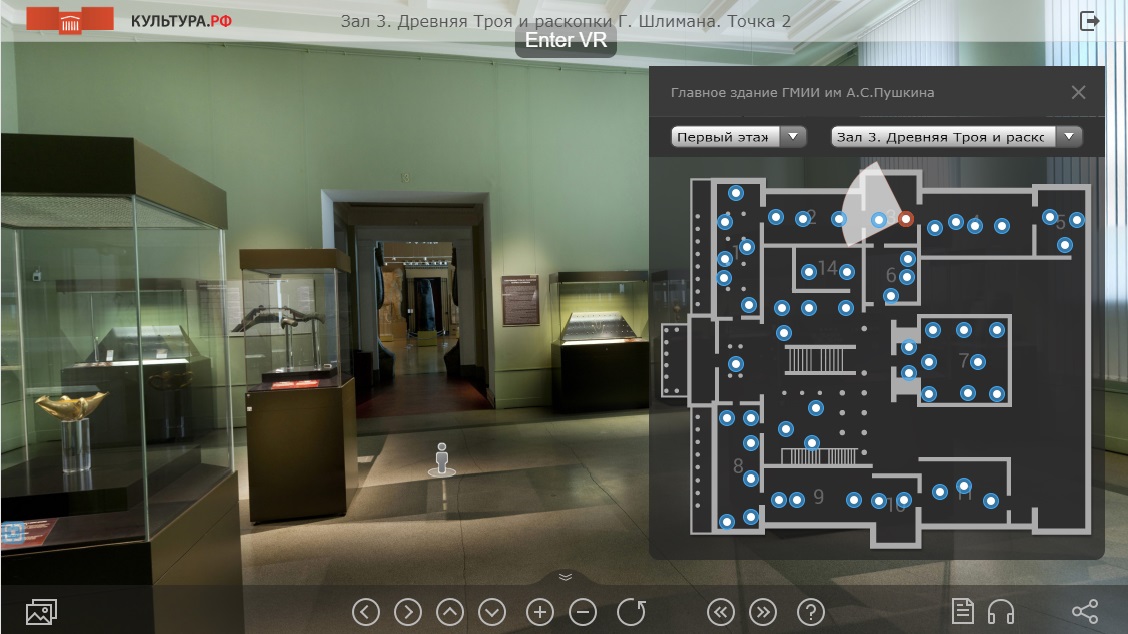'A' is the largest and most interesting of the Treasures. It consisted of 183 objects, of which 101 are held in the Pushkin State Museum of Fine Arts. It included 19 vessels made of gold and silver and in one of these two gold diadems were found, a forehead band, earrings in the shape of small baskets, temple rings, bracelets, torques and also numerous gold beads and pendants.
The two diadems – the Large and the Small Diadem, made up of hundreds of tiny elements – number among the most remarkable works of ancient art (showcases № 8 and 9). The earrings fashioned in the shape of tiny baskets, to which pendants reminiscent of 'idols' (showcase № 7) are attached on tiny chains, stand out on account of their striking delicacy. Pendants fashioned in all manner of shapes also hang from the strings of gold beads (showcase № 7). Unfortunately it is not known what these particular items of jewellery looked like in antiquity. The beads were strung together arbitrarily back in Schliemann's day and then attached at each end with the seal of red sealing-wax on which the letter 'S' was impressed. It is possible that this was Schliemann's own seal, but it is also possible that they belonged to Hubert Schmidt, who compiled the first catalogue of the collection.
Among the vessels found in Treasure 'A' the so-called anthropomorphic ones stand out, which have been forged from whole pieces of thin silver, which have lids, or stylized 'heads', that can be removed (showcase № 1). Straps were inserted through the vertical openings on the caps and handles of the vessels, which held the lids in place. It is most likely that aromatic oils and fragrances were kept in them. A spherical gold vessel with a short narrow neck (showcase № 6) could well have been designed for the same purpose. On its surface traces of three tiers of vertically arranged rhombi can be discerned in some places. It is assumed that these are impressions from a net made of organic material in which the vessel, without a flat base, would have been suspended.
An equally remarkable work of art is the unique gold boat-shaped vessel with two spouts, sometimes referred to as a 'sauce-boat' (showcase №14). Certain metal vessels and fragments of pottery ones are of similar shape, yet there are no exact parallels for this 'sauce-boat'. It is most likely that the vessel had been designed for ritual ceremonies and, like the anthropomorphic vessels showing traces of repair, had been used over a long period: thus it may well have been that in antiquity one of the spouts was re-forged and rather carelessly.
Among the five bracelets in the collection, one from Treasure 'F' (showcase № 4) stands out in particular. The broad band of the bracelet is decorated with rows of spiral patterns and rosettes. As regards to the way this decoration has been executed, it is reminiscent of the head of a gold pin embellished with six miniature two-handled vessels (Treasure 'O'; showcase № 4). Each tiny amphora is made up of seven elements welded together.
A special place among the Trojan hoards belongs to Treasure 'L' found by Schliemann not long before his death in 1890. It included four ceremonial hammer-axes (showcase № 15) and various objects made of rock crystal, including six mace terminals or sword handles, and also round plates so-called 'lenses' (showcase № 16). On some of the lenses there are traces of iron and bronze oxides, which has led certain scholars to regard them as plates from a bronze belt or casket, while others have suggested that the lenses served as counters for a game. Finally the large round 'lense' could have been used as a magnifying glass, since it magnifies everything roughly twice over. Exceptional importance is attached to the hammer-axes. One is made of blue lazurite and three are made of nephritoid and jadeite. Schliemann himself considered them more significant than everything else found at Troy. The upper parts of the axes are decorated with rows of knobs and ridges in relief imitating the decoration used for metal objects. Traces of gilding have been found on the knobs of two of the axes. The careful polished surfaces, the curved blades, traces of gilding and also the actual materials were used to indicate the ceremonial character of these axes, which had probably been made in Troy itself. Axes of a similar shape were well-known in the middle and second half of the III millennium BC, but these specimens from Troy are superior to them, because of the skilled working of the stone and also the manner of their decoration.




